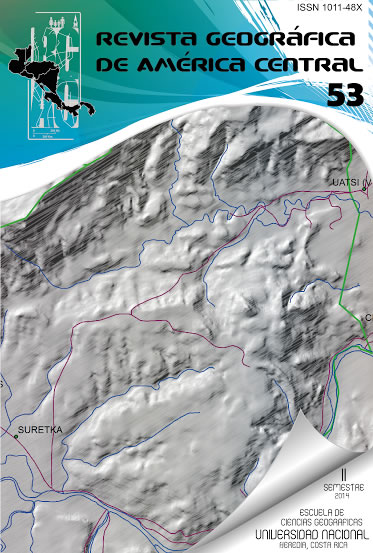ALTERNATIVE SOLUTION FOR DIRECT TRANSFORMATION OF GEOGRAPHIC INFORMATION: THE CASE OF COSTA RICA CHANGING THE OFFICIAL SYSTEM OF COORDINATES (LAMBERT TO CRTM05)
DOI:
https://doi.org/10.15359/rgac.2-53.1Keywords:
Datum, Transformation, Projection, Lambert, CRTM05Abstract
For many years, Costa Rica officially used cartography based on the Lambert projection system, datum Ocotepeque. In 2007 the official reference system was changed to CR05, forcing public institutions to transform all their cartography to this new system. This change affects the way new spatial information is generated and also involves the transformation of all the previous cartography to the country’s new official system. Therefore, it’s necessary for these institutions to establish an appropriate methodology for the conversion, considering the scale and accuracy of their cartographic products. This paper proposes a methodology that allows for direct transformation of the spatial data contained in the former system to the official reference system CR05. The results of this research provide public and private institutions alike in Costa Rica a simple and efficient method to transform their digital maps by setting up Geographic Information System platforms, thus reducing the costs and time in converting their data.
References
Badekas, J. (1969). Investigations Related to the Establishment of a World Geodetic System. Report No. 124, Department of Geodetic Science and Surveying, Ohio State University, USA.
Bursa, M. (1965). Fundamentals of the Theory of Geometric Satellite Geodesy. Travaux de l’institut Geophysique de l’academie Tehecoslovaque des Sciences, 241.
Costa Rica. (2007a). El sistema de referencia CR05 y la proyección Transversal Mercator para Costa Rica. Programa de Regularización de Catastro y Registro de Costa Rica.
Costa Rica. (2007b). Decreto ejecutivo 33797-MJ-MOPT. Ministerio de Justica y Gracia. Costa Rica.
DMA. (1991). Department of Defense World Geodetic System 1984: Its definition and Relationship with Local Geodetic Systems. Technical Report, (8350.2), Defense Mapping Agency, USA.
Grafarend, E. (2010). Algebraic Geodesy and Geoinformatics. SpringerVerlang, Wien, New York.
Hofmann, B., Lichtenegger, H. & Collins J. (1992). Global Positioning System Theory and Practice. Second edition. Springer-Verlang, Wien, New York.
IAGS. (1950). Proyección Lambert Para Costa Rica. InterAmerican Geodetic Suvey, USA.
Jekeli, C. (2002). Geometric Reference Systems. Department of Civil and Environmental Engineering and Geodetic Science, The Ohio State University, Columbus, Ohio.
Keller, W. (2001). Geodetic Coordinate System. Geodetic Institute, University Stuttgart.
NIMA. (1997). Department of Defense World Geodetic System 1984, its Definition and Relationships with Local Geodetic Systems. Third edition. National Imagery and Mapping Agency.
Rapp, R. (1985). Geodesia Geométrica, Volumen II (Técnicas avanzadas).Agencia Cartográfica de Defensa, Servicio Geodésico Interamericano. Escuela Cartográfica. Panamá, DMA-IAGS CT-6.
Wolf, H. (1963). Geometric connection and re-orientation of threedimensional triangulation nets. Bulletin Geodesique, 68, 165-169.
Downloads
How to Cite
Issue
Section
License
Proposed policy for journals offering Open Access
Authors publishing their works in the Journal acknowledge and agree to the following terms:
a) Authors retain the copyrights to their works and guarantee the Journal the right to be the first to publish their works, under the Creative Commons License Attribution-NonCommercial-ShareAlike 4.0 International, CC BY-NC-SA 4.0 International (https://creativecommons.org/licenses/by-nc-sa/4.0/deed.es), which allows others to share works upon complying with the acknowledgment of authorship and mention of the Journal as the original publisher of the work.
b) Authors are permitted to separately establish additional agreements for the non-exclusive distribution of the official edition of the work published in the Journal (for example, authors may desire to place the work in an institutional repository or incorporate it into a book that is to published elsewhere) so long they acknowledgment to recognize the Journal as the original publisher. The aforementioned additional agreements must respect the terms of the non-profit character and sharing philosophy of the original license (CC BY-NC-SA 4.0 International, https://creativecommons.org/licenses/by-nc-sa/4.0/deed.es).
c) Authors are encouraged to archive the post-print or editor/PDF version in Open Access repositories.






 REVGEO is licensed under https://creativecommons.org/licenses/by-nc-sa/4.0/deed.es
REVGEO is licensed under https://creativecommons.org/licenses/by-nc-sa/4.0/deed.es
.svg_4.png)

_(1).png)
_(1)_(1)_(1)_1.png)
(2)(1)(1)(1).png)
